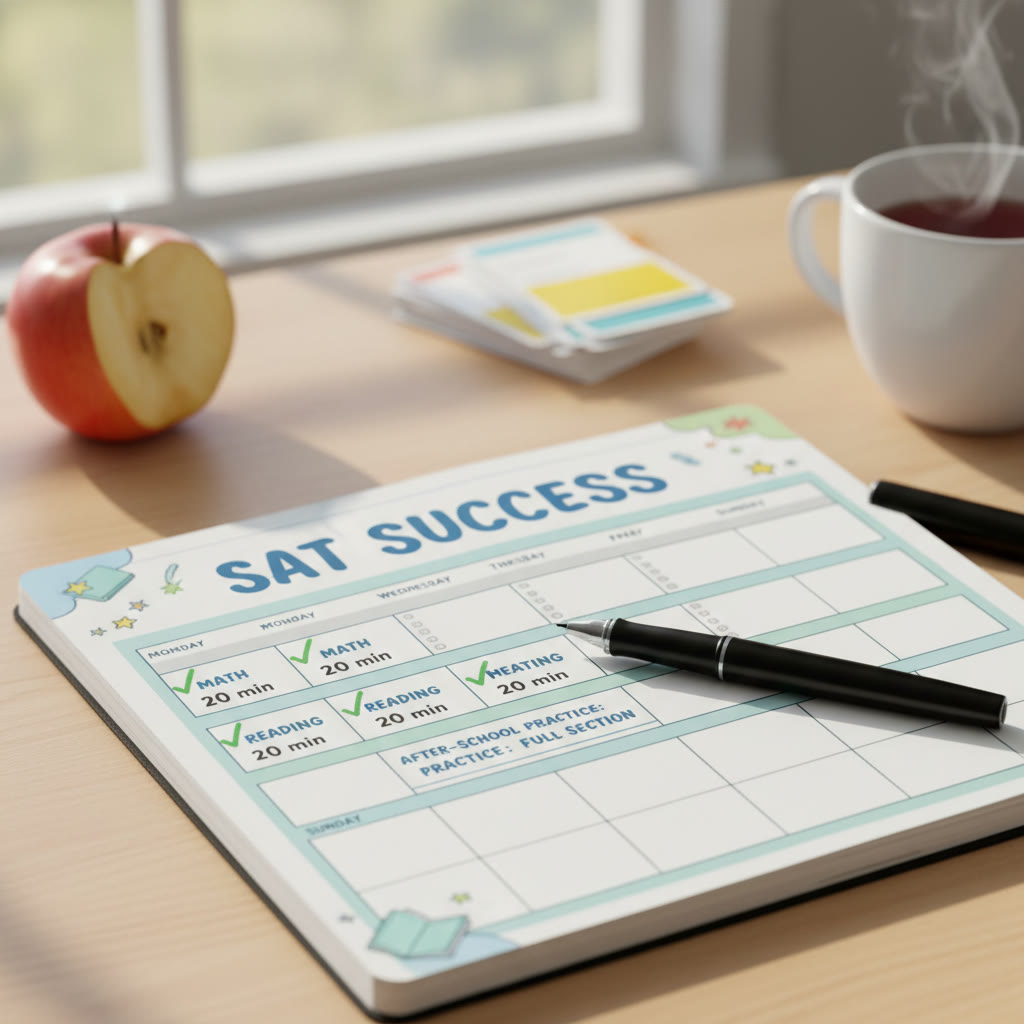Why Folding SAT Prep Into Your School Day Works Better Than Cramming
There’s a myth in the student world that SAT success comes from marathon study sessions and last-minute panic. In reality, steady, intentional practice beats cramming every time. Integrating SAT prep into your daily school routine makes studying sustainable, reduces test anxiety, and builds real skills that transfer to your classes. You don’t have to add hours to your day — you just have to use small blocks of time deliberately.
Small, Consistent Effort Trumps Occasional Intensity
Think of SAT practice like building muscle. Lifting a little most days leads to better strength gains than one grueling workout per week. Short, focused sessions improve memory retention and reduce burnout. Over a month, ten 30-minute sessions will give you far more progress than three three-hour sessions that leave you exhausted and unmotivated.
Real-World Benefits Beyond the Test
When SAT prep is woven into schoolwork, you notice immediate benefits: sharper reading comprehension in English class, more confident math problem-solving, and improved time management. This crossover effect means the time you invest helps your grades now and your college application later.
Getting Started: Mindset, Goals, and a Tiny, Honest Audit
Before you change your schedule, take five minutes to be honest with yourself. What are your weaknesses? Which sections of the SAT are realistic priorities right now? Where do you already spend time that could be nudged toward prep? That tidy little audit is the baseline you’ll measure progress against.
Set a Real, Measurable Goal
A goal like “raise my score by 120 points in 3 months” is actionable. So is “improve my reading section accuracy on dual passage questions to 85%.” Make goals specific, trackable, and time-bound. Break them into weekly targets so progress feels manageable and visible.
Pick a Tiny First Step
Start with something simple: five SAT-style problems each weekday morning, one 20-minute vocabulary session after school, or a single reading passage on the bus. Small actions reduce friction and build momentum — and momentum is the secret ingredient of long-term improvement.
Designing a Weekday Routine That Fits School Life
Your school day has pockets of predictable time. The trick is using those pockets consistently. Below are ideas to slot into your weekdays without creating a time sink.
Morning: 10–20 Minutes of Alert Practice
- Use 10–20 minutes after waking up for light, focused tasks: a short reading passage, a few vocabulary flashcards, or one math warm-up problem. Your mind is fresh and less distracted first thing.
- Keep materials ready the night before: a single printed passage, a flashcard set, or a one-page math review. Eliminate decision fatigue.
Between Classes and Study Halls: Micro-Sessions (5–15 Minutes)
- Turn waiting time into practice. Answer one multiple-choice question or correct one paragraph for grammar in a notebook.
- Use a pocket-sized planner or phone timer to enforce micro-session length and keep it exact — short, focused bursts beat distracted multitasking.
After School: 30–60 Minutes of Deep, Purposeful Practice
This is your main daily slot. Prioritize quality over quantity: pick a single target (data interpretation for math, command of evidence in reading, or punctuation rules in writing) and practice deliberately with immediate review.
Subject-Specific Routines: How to Make Each Section Routine-Friendly
Different SAT sections demand different habits. Here’s how to build small, repeatable routines around each one so they fit into your school day naturally.
Reading: Build a Habit of Active Reading
- Morning 10-minute passage: read fully and write a one-sentence summary in the margin. That habit builds main-idea recognition and speeds up comprehension.
- Class crossover: when assigned readings for English or history, practice identifying the author’s main thesis and two supporting details — the same skill SAT reading tests.
- Weekly focused review: once a week, do a timed set and analyze mistakes by question type (vocabulary-in-context, dual passages, detail questions).
Writing & Language: Edit Everywhere You Can
Grammar and clarity are skills you can practice in the margins of schoolwork. When you proofread an essay or lab report, pause to consider parallelism, subject-verb agreement, and sentence structure. That real-world practice mirrors the SAT’s emphasis on clarity and economy of expression.
Math: Frequency Beats Volume
- Daily problem: one algebra or geometry problem in the morning to warm up logical thinking.
- During math class, take mental notes of problem-solving techniques you’d normally forget — this turns class examples into SAT strategies.
- Use practice problems to reinforce formulas rather than memorizing; explain the steps aloud or in writing to lock processes into memory.
How to Use Practice Tests Without Losing Your Week
Full practice tests are essential, but they don’t need to be weekly. Overdoing full-length tests can burn out even the most driven students and distort progress measurement if you don’t analyze results carefully.
Smart Cadence for Full-Length Tests
- Take a full practice test every 2–3 weeks during the height of prep, then once every 4–6 weeks earlier in your preparation. Frequency should match your test date and total study time.
- Alternate full tests with focused sectional tests so you practice stamina and technique without overscheduling.
Reviewing Tests: The Step Nobody Skips on Purpose
Doing a test without a disciplined review is like running a race and never looking at your time. Use a mistake log: for each missed question, record the type, the reason for the mistake (conceptual, careless, time-pressure), and the corrective action. This is where the real score gains live.
Sample Weekly Schedule (Easy to Customize)
Below is a practical template you can adapt. The idea is to sprinkle micro-sessions through the day and devote one concentrated after-school slot to a deep practice or section review.
| Time | Monday | Tuesday | Wednesday | Thursday | Friday | Weekend |
|---|---|---|---|---|---|---|
| Morning (10–20 min) | Reading passage + summary | Vocabulary flashcards | Math warm-up problem | Grammar quick edit | Reading passage | Full practice section or light review |
| Between classes (5–15 min) | 1 grammar question | 1 math problem | 1 vocab in context | Problem of the day | Quick error log review | Timed sectional practice |
| After school (30–60 min) | Deep reading review | Math focused practice | Writing & Language drills | Mock timed section | Review weak concepts | Full practice test or targeted review |
| Evening (10–20 min) | Log mistakes | Flashcard recap | Mindful reading | Review formulas | Plan next week | Rest and light review |
How to Customize the Template
Swap in more math if your scores lag there. If reading is your lowest section, add an extra passage once mid-week. The table is a skeleton — your specific weaknesses and school schedule will shape the final form.
Using Shortcuts and Tools Without Losing Rigor
Quality tools speed you up, but they don’t replace disciplined practice. Tools can remind you to study, track progress, and give targeted practice. For example, tailored tutoring platforms that offer 1-on-1 guidance and customized study plans can help convert weak areas into manageable tasks. Sparkl’s personalized tutoring blends expert tutors with AI-driven insights to pinpoint where to spend your micro-session time and supply targeted practice so you don’t waste the short windows in a school day.
What to Expect from Smart Tutoring
- Personalized study plans that fit around your classes and extracurriculars.
- 1-on-1 guidance to fix recurring mistakes quickly.
- Data-driven feedback (sometimes AI-powered) to highlight the highest-impact actions for each study session.
Real-Life Examples: Two Student Profiles
Seeing routines applied to real schedules clarifies how flexible this approach can be.
Case 1: Julia — Busy Junior with APs
Julia has AP classes and rehearsals after school. She uses 10 minutes each morning to do a reading passage, 10 minutes between school and rehearsal to review a math formula, and a 40-minute after-school block twice a week for focused math practice. She takes a full practice test every three weeks and uses her mistake log to guide her targeted sessions. Because she’s juggling a lot, she benefits from a personalized study plan that maps SAT goals to the weeks she has fewer extracurriculars.
Case 2: Marcus — Senior with Work Commitments
Marcus works part-time and can’t spare long afternoons. He leans on micro-sessions: quick vocab bursts on his commute, a 20-minute sectional practice on his lunch breaks, and a single 60–90 minute practice block on weekends. By tracking progress and focusing on the highest-leverage question types, he improves steadily without burning his schedule.
How to Track Progress Without Getting Obsessed
Tracking progress should motivate, not torture. The simplest tracking method is a weekly score-and-skill snapshot: one line for your latest practice score and three bullet points that list the top skills to improve next week.
Mistake Log: Your Compass for Smart Study
Keep a running mistake log with three columns: question type, error category (conceptual, careless, timing), and corrective step. Reviewing this once a week helps you spot patterns and prevents repeating the same mistakes in different disguises.
Monthly Checkpoints
Every four weeks, compare full practice test scores and review whether the weekly micro-sessions are producing the expected gains. If not, adjust: change the focus, lengthen an after-school block, or seek targeted 1-on-1 help for stubborn weaknesses.
Staying Motivated and Avoiding Burnout
Routine is powerful, but life happens. The best routines are flexible and include recovery. Build in micro-rewards and non-negotiable rest.
Small Wins and Celebrations
- Celebrate improvement in process, not just score: a week with no careless errors, faster pacing on reading, or correct steps on complex math problems.
- Schedule a fun activity after a big practice test so the post-test slump doesn’t turn routine into punishment.
When to Pause
If you feel persistent exhaustion, your retention will drop. It’s better to take a short break and return refreshed than to study through foggy thinking. A day off after an intense practice test can be restorative and help consolidate learning.
Bringing It All Together: A Week That Feels Natural
By folding SAT prep into the rhythms of your school day, you convert wasted minutes into targeted learning. The plan is simple: morning warm-ups, micro-sessions between classes, one focused after-school practice, and disciplined review. Use a mistake log to make every minute count and let monthly checkpoints guide strategic adjustments.
Where Personalized Help Fits In
If certain patterns resist change, personalized tutoring can be a powerful accelerant. Tutors who offer tailored study plans and 1-on-1 guidance help convert stubborn weaknesses into strengths faster than solo practice. Sparkl’s personalized tutoring combines expert tutors with AI-driven insights to identify which micro-sessions will move your score the most — a useful support when your schedule is full and time is precious.
Final Thought: Progress Is a Series of Small, Purposeful Habits
The SAT is a predictable, learnable test. The path to improvement isn’t flashy; it’s steady. Integrate practice into your daily life in small, intentional chunks, track what you learn, and adjust with data. Over time, those minutes add up into real score gains — and into habits that make school and college more manageable. If you combine smart routine-building with targeted, personalized guidance when you need it, you’ll arrive at test day ready and confident.















No Comments
Leave a comment Cancel